How rainforest shamans treat disease
Rhett A. Butler, mongabay.com
November 10, 2009
Physician Christopher Herndon explores how Amazon shamans diagnose and treat disease.
Ethnobotanists, people who study the relationship between plants and people, have long documented the extensive use of medicinal plants by indigenous shamans in places around the world, including the Amazon. But few have reported on the actual process by which traditional healers diagnose and treat disease.
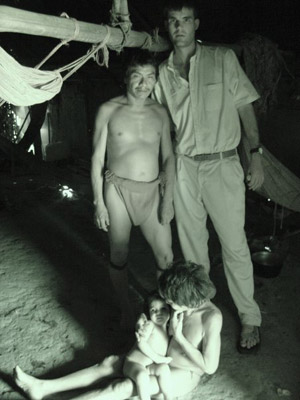 Christopher Herndon with Eñepa healer and family, Venezuela |
The knowledge and treatments of shamans is the product of their own scientific method, accumulated from a progressive cycle of trial, experiment and observation repeated over countless generations. It may not be transmitted in Science or Nature but in many ways is fundamentally based on the very same empirical and pragmatic principles as Western science.
Lead author Christopher Herndon, currently a reproductive medicine physician at the University of California, San Francisco, says the findings are a testament to the under-appreciated healing prowess of indigenous shamans.
"Our paper contests a prevailing view in the medical establishment that we, as scientists, have nothing left to learn from so-called 'primitive' societies," he told mongabay.com. "Our 'Western' medical system is itself but a compendium of knowledge, wisdom and therapeutics accumulated from past cultures and societies from around the world. We should be justifiably proud of the accomplishments of medical science, but at the same time not lose perspective that these advancements, in many cases, emerged only in the past half-century. My point is that we should not be so quick to sever the umbilical cord of our medical system from the womb of the last remaining cultures that helped gave it birth. We do so at our great loss."
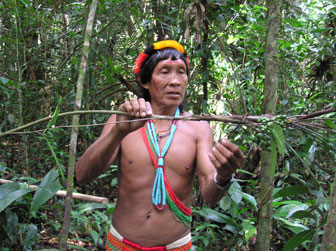 Amasina, a Trio shaman in Suriname and co-author on the Journal of Ethnobiology and Ethnomedicine paper. Photo courtesy of the Amazon Conservation Team. |
But the situation is changing for the Trio, thanks in part to the pioneering efforts of the Amazon Conservation Team (ACT), a "biocultural" conservation group that collaborated with Herndon (together with a Trio shaman named Amasina and the Suriname Ministry of Health) on the research. ACT has established a system of traditional health clinics to improve healthcare and promote medicinal plant knowledge among younger members of the tribe by bridging the gap between youths and healers (the average age of shaman in the study was 68, an approximate age as all were born prior to contact).
"One cannot 'save' the medical systems of indigenous tribes alone through written inventories of their medical plant knowledge," Herndon explained. "Trio ethnomedicine, not unlike our healing tradition, is a complex art of diagnosis, examination, communication, ritual and treatment that can only be transmitted through active practice. The disintegration of traditional systems of health is most devastating to indigenous peoples, who at the same time often have very limited access to extrinsic medical resources. The adoption by organizations of programs that strengthen and retain tribal peoples' self-sufficiency is critical for their health as well as to enable the transmission of these remarkable medical systems for the benefit of future generations."
In a November 2009 interview with mongabay.com, Herndon discussed his research, the diagnostic practices and healing power of shamans, and the importance of biocultural conservation in the Amazon.
AN INTERVIEW WITH CHRIS HERNDON
Mongabay: What is your background and how did you become interested in healing practices of indigenous shamans?
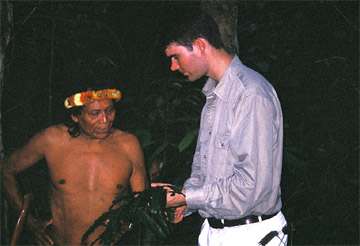 Paramount shaman of the Sikiyana tribe in Suriname rainforest teaching Herndon treatment for kidney infections |
Mongabay: How did you come to work with the Trio in a remote part of the Amazon?
Christopher Herndon: No region captured my fascination more than Amazonia, the world's greatest expanse of rainforest and repository of botanical diversity. In medical school, I became involved with the Amazon Conservation Team (ACT), an organization based in Arlington, Virginia, founded by Mark Plotkin and a small handful of leading conservationists. Plotkin was a student of the great ethnobotanist Richard Evans Schultes and had worked for over twenty years with the Trio, a tribe inhabiting the remote headwaters of the Suriname Amazon.
 Mark Plotkin with Amasina. Photo courtesy of the Amazon Conservation Team.
|
I spent my first summer of medical school deep in the Suriname rainforest working closely with the Trio shamans developing this project, at the same time learning about their medical practices and use of medicinal plants. It was the start of a journey that would carry through a decade.
Mongabay: How were you treated by the Trio? Did the shamans find it strange to be observed by a Westerner?
Christopher Herndon: I think from Plotkin's earlier work, the Trio had become accustomed to outside interest in their botanical knowledge. They seemed quite surprised, however, to find a pananakiri (foreigner) interested in their understanding of disease and diagnostic techniques as healers. The shamans responded at first to my eagerness to learn with more of a skeptical curiosity than anything else. Over time, our relationship deepened and we would spend hours each day discussing diagnosis and management of disease conditions. They shared with me their approaches to the evaluation and examination of patients. On treks in the rainforests, they taught me not only their use of medicinal plants, but also their chants and rituals, which had long been suppressed by the missionaries.
 Christopher Herndon with Hoti children, Venezuela |
I always approached the shamans - whom I referred to as tamo (grandfather) - with the respect and humility of a student, an apprentice. I think our paper is a testament to the trust and close partnership we maintained with our indigenous colleagues from the start of the project.
 Location of the study sites. |
Mongabay: In what ways was your study built on prior work examining Amazonian shamanism?
Christopher Herndon: Scientists often approach the study of other cultures with the tunnel-vision of their own specialty training. To understand these complex healers – who are the tribal equivalent of physician, herbalist, psychiatrist and priest – one needs to look through a broader lens.
 Kwamalasamutu ("Kwamala") |
This dearth of scientific studies contributed to a widely-held perception that the medical knowledge of tribal shamans was ‘primitive' in comparison to their more recognized abilities, such as sophisticated empiric plant chemists. Retrospectively, it made no sense that these healers would possess such incredible therapeutic knowledge without a well-developed understanding of disease to guide their use.
Mongabay: What are the results of your work? What type of illness did the Trio shamans treat?
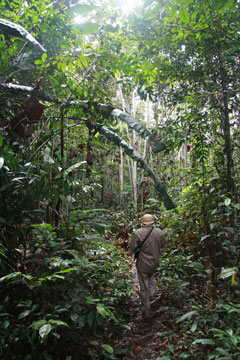 Jonathan, head of the indigenous park guard program for Kwamalasamutu, on patrol in the Amazon rainforest. Photo by Rhett A. Butler |
In our interviews, Trio shamans presented highly detailed and specific descriptions of disease characteristics and associated symptomatology. They frequently commented on disease associations and responsiveness to therapy, often demonstrating a remarkable insight into the natural history of disease processes as we understand them. Most significantly, we recorded the same knowledge from shamans from distant Trio villages indicating the presence of a highly formalized and conserved medical institution within the tribe.
Mongabay: Did the Trio treat any 'new' diseases (i.e. diseases that have been introduced since first contact)?
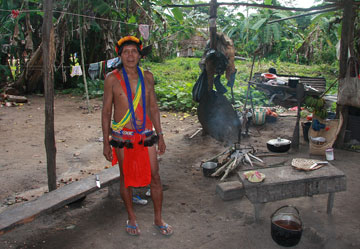 Amasina. Photo by Rhett A. Butler.
|
Mongabay: Are we any closer to understanding how they gained this wealth of information? Who do shamans credit for their knowledge?
Christopher Herndon: Learning from an elder shaman is not that different from being taught by a silver-haired, bow-tied professor on the wards of our own medical institutions. The knowledge and wisdom the elder shamans possess are those which can only be derived through a lifetime of experience in treating patients. This is precisely why the medical systems of these tribes, in which healing knowledge is usually specialized to just a few individuals, are so fragile. The apprenticeship of a shaman can last many years. Speaking as someone still in postgraduate fellowship training, now six years from medical school, perhaps our system may not be so different as we might like to think!
Mongabay: What can Western medicine learn from your findings and more generally, indigenous healing practices?
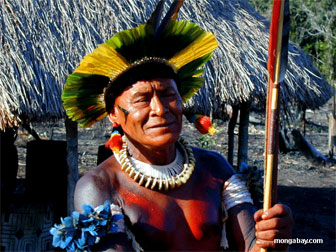 Kayapo shaman in Brazil. |
Mongabay: Can you cite an example?
Christopher Herndon: Beyond therapeutics, one aspect is the shaman's ability to communicate with patients and to engage them as participants, rather than subjects, in the healing process. Despite the great technological successes of modern medicine, thousands of patients in our country feel increasingly disenfranchised by the medical system and, more broadly speaking, there is a sense of devaluing of the doctor-patient relationship. Patients - often highly intelligent and informed individuals - not uncommonly seek something else and reach out for diverse array of complementary and alternative medicines which are not well established. The rare chance to learn from these elder Amazonian shamans, as one colleague remarked to me, is the opportunity to enroll in one of the greatest training programs for complementary and alternative medicine. They are among the last remaining masters of their ancient craft.
Mongabay: Your research took place among the Trio in Suriname but have you observed shamanic practices in other parts of the Amazon? Did you see differences?
Christopher Herndon: Over the past decade, I had the opportunity to work with healers from a wide diversity of tribes throughout Amazonia. The medical systems of each tribe are different. In some tribes, shamans utilize plants which might be considered hallucinogens in our science to connect with the spiritual world to seek a diagnosis. In one nomadic hunter / gather group, medicinal knowledge is not strictly specialized to a central shamanic figure, but rather disseminated more broadly throughout the tribe. Beyond these differences, I witnessed a shared commonality among the indigenous healers in their remarkable sophistication of medical knowledge and skills. Moreover, I found them willing to share their knowledge, when approached with respect, as well as having an intellectual curiosity regarding our own system of healing.
Mongabay: Missionaries discouraged traditional practices after they settled among the Trio. Was there any persecution of healers? Are there any signs that knowledge has been lost as a result of this?
 Herndon evaluating a sick child with Eñepa healer, Venezuela |
Mongabay: How are healers viewed in communities today?
Christopher Herndon: One of the most satisfying aspects of my work with the traditional clinic program was observing the elder shamans restored to positions of honor in the villages. At the opening ceremony of the first clinic, an elder Trio shaman stood up and proclaimed it was the first time in thirty years that he could publicly acknowledge he was a shaman. In more acculturated indigenous communities I visited in Suriname and elsewhere, there usually was either no longer a shaman remaining or their traditional medical system comprised a single individual marginalized to the outskirts of the village, long inactive as a healer and forgotten by the tribe.
The traditional clinic program among the Trio went on to be a tremendous success – receiving thousands of visits over several years – a comparable number as the village health outpost. The program was subsequently successfully replicated in two other tribes in Suriname and received international recognition. I believe keys to its success were the full autonomy of the elder shamans in directing its operation as well as the strong partnership with Medische Zending Suriname, the regional health care provider.
Mongabay: What do you see as the best way to retain indigenous knowledge that is increasingly lost due to cultural transformation and assimilation?
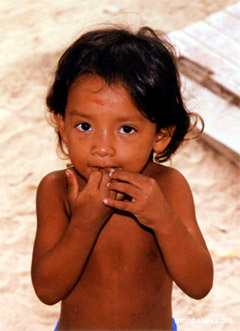 Photo by Rhett A. Butler |
AUTHORS: Christopher N Herndon, University of California, San Francisco; Melvin Uiterloo, Amazon Conservation Team Suriname; Amasina Uremaru, Trio indigenous community of Kwamalasamutu, Sipaliwini District, Suriname; Mark J Plotkin, Amazon Conservation Team; Gwendolyn Emanuels-Smith, Amazon Conservation Team Suriname; and Jeetendra Jitan, Ministry of Health, Paramaribo, Suriname.
CITATION: Herndon et al. Disease concepts and treatment by tribal healers of an Amazonian forest culture. Journal of Ethnobiology and Ethnomedicine 2009 5:27 doi:10.1186/1746-4269-5-27
Copyright mongabay 2009
http://news.mongabay.com/2009/1110-herndon_amazon_shaman.html